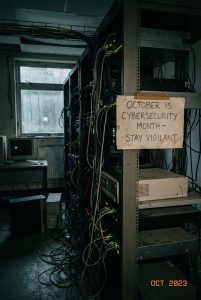June 16, 2025
You set it. You forget it.
And just like that, while you're packing for vacation, your inbox starts auto-broadcasting:
"Hi there! I'm out of the office until [date]. For urgent matters, please contact [coworker's name and e-mail]."
Sounds harmless, right?
Think again.
That simple, friendly Out-of-Office (OOO) reply?
It's a gold mine for cybercriminals looking for their next easy target.
🕵️ Why Auto-Replies Are a Hacker's Dream
A typical OOO message might include:
-
Your full name and title
-
Dates you're unavailable
-
Alternate contact names and emails
-
Team structure clues
-
Even your location or event: "I'm at a conference in Chicago..."
That info gives attackers two major advantages:
1️⃣ Timing
They know exactly when you're not watching your inbox.
2️⃣ Targeting
They know who to impersonate—and who to pressure.
That's the foundation for a perfect phishing scam or business email compromise (BEC).
🎣 How the Scam Usually Plays Out
-
Your auto-reply message goes out.
-
A hacker uses the info to impersonate you or your listed backup.
-
They send an "urgent" email to a colleague requesting a wire transfer, credentials, or a sensitive file.
-
The colleague, acting in good faith, assumes it's legitimate.
-
You return from vacation to discover that $45,000 just went to a fake vendor.
This type of social engineering attack is shockingly common—especially for businesses that travel frequently.
🧳 Traveling Teams Are Especially at Risk
If your company has staff who:
-
Travel regularly (sales teams, executives, consultants)
-
Have assistants handling email or tasks while they're away
-
Frequently delegate sensitive tasks like payment processing
…you're in the perfect storm for email-based fraud.
Admin staff are used to acting fast, handling multiple requests—and trusting familiar names.
All it takes is one convincing fake email.
🔒 How to Protect Your Business From Auto-Reply Exploits
OOO messages aren't inherently bad. But they need to be smart.
Here's how to stay secure:
✅ 1. Keep It Vague
Avoid specific dates, locations, or backup contacts if possible.
Better:
"I'm currently out of the office and will respond upon my return. For immediate assistance, please contact our main office at [main number or inbox]."
✅ 2. Train Your Team
Make it policy:
-
Never act on email-only requests for money, passwords, or files.
-
Always verify unusual or high-risk requests with a second channel (like a phone call).
✅ 3. Strengthen Your Email Security
Use:
-
Anti-spoofing tools (SPF, DKIM, DMARC)
-
Advanced phishing filters
-
Role-based email permissions
✅ 4. Require MFA
Enable multifactor authentication on all accounts.
If a password gets stolen, MFA often blocks access.
✅ 5. Work With a Proactive IT Partner
A cybersecurity-focused IT team will:
-
Detect login anomalies
-
Monitor for phishing attempts
-
Shut down suspicious activity before it turns into financial loss
🌴 Want to Vacation Without Becoming a Hacker's Next Target?
You deserve time off without worrying about your inbox being used against your team.
Let's secure your systems before cybercriminals try to take advantage.



